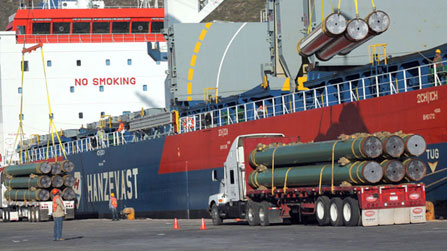Pipeline buildup promotes fossil fuel consumption, energy dependence

Ships unload pipe onto trucks in Topolobampo for construction of natural gas lines (Photo: courtesy TransCanada Corp.).
MAZATLAN
The foreign pipeline corporation most spurned by the people and presidency of the United States has been currying favor steadily with their Mexican cohorts, and expects to put into service two natural gas conduits here in Sinaloa before the end of the year.
The Canadian corporation won its seventh 25-year pipeline construction contract with Mexico’s Federal Electricity Commission in June 2016. The new contract comes on top of the two here on the Northwest Coast.
One, the Topolobampo line, crosses the Copper Canyon to El Encino, Chihuahua, and the other, the Mazatlán line, goes to El Oro, 50 kilometers northeast of Topolobampo.
Celebrating its latest lucrative investments, the company, TransCanada Corp., boasted that Mexico has “adopted” it and that General Manager of Mexico Operations, Robert Jones, “sees no end, either in the short or long run, to the opportunities for projects.”
Jones noted that TransCanada Corp. has “established an impressive record in the country … working with local and indigenous communities, and treating people with respect. Because of these values, TransCanada has been adopted in Mexico,” he said in an Aug. 2 announcement.
TransCanada Corp. recently lost a multi-year fight for permission to build a pipeline from the oilfields of Canada across the U.S. border and through the agricultural heartland of the United States to slurry tar-sands crude to refineries and export facilities on the Gulf of Mexico.
The U.S. administration nixed the permit for that project, the Keystone XL Pipeline, in the wake of strident opposition from indigenous and other rural peoples whose land and water are at risk from spills of pipelines carrying hazardous toxic petroleum products.
TransCanada’s first tar-sands crude slurry line through the heartland spilled 14 times in the first year of operations on the route from Canada through North Dakota, South Dakota, Nebraska, Kansas, Missouri and Illinois.
TransCanada Corp. now is suing the United States in federal court and in the international tribunal of the North American Free Trade Agreement for the loss of expected income due to the denial of the permit for Keystone XL private infrastructure project, which would have been the company’s second tar-sands crude slurry line.
The legal action has aroused the disgust of climate justice activists and clean energy advocates who fought the profit-motivated endeavor in hopes of curbing greenhouse gas proliferation by reducing fossil-fuel transportation options.
“One can’t deny the impact of halting a major pipeline project,” the non-profit Natural Resources Defense Council said. “The moref dirty oil left underground in the north, the more space left for clean energy to grow.”
The tar sands industry once had plans to triple production of one of the dirtiest fuels on the orb by 2030, but now it’s canceling those mining contracts by the dozens.
TransCanada Corp., its schemes defeated at least temporarily in the United States, is gaining a bigger and bigger toehold in Mexico. It already owns and operates a Manzanillo-Guadalajara natural gas pipeline and another in Tamazunchale, in the central Mexican state of San Luís Potosí. It expects to break ground soon on a Tamazunchale Pipeline Extension.
The company garnered Raramuri assent to accomplish the construction of the Topolobampo line across the Copper Canyon, by providing many gifts of baseball equipment, school supplies, educational infrastructure and community buildings.

TransCanada Corp. showered the Raramuri with gifts In exchange for their backing of the Topolobampo line across the Copper Canyon. (Photo: courtesy TransCanada Corp.).
TransCanada Corp.’s Mazatlán pipeline segment reaches to another new gas line in El Oro, which runs 330 kilometers from there to Guaymas. The El Oro-Guaymas segment, part of Gasoducto Sonora, as it is called, currently is under construction by a subsidiary of Infraestructura Energética Nova, S.A.B. de C.V., (IEnova), previously Sempra Mexico, itself a subsidiary of Sempra Energy, a Fortune 500 energy services holding company based in San Diego, California.
IEnova also is building a 500-kilometer segment to transport natural gas from Sásabe to Guaymas, Sonora. The company has finished building a stretch between Sásabe and Puerto Libertad, which was not yet in operation by August 2016.
Meanwhile, IEnova and TransCanada Corp. are working together on the Sur de Texas-Tuxpan gas line.
The Mexican presidency has TransCanada Corp.’s unbridled support for privatization of the energy sector and boosting power consumption. The company foresees a 75-percent increment in Mexico’s natural gas demand as a result.
“Mexico will make an important contribution to TransCanada’s vision of becoming one of the leading energy infrastructure companies in North America,” corporate literature declares.
“There is no question about President Enrique Peña Nieto’s unbending commitment to the speed of the country’s historic energy reform,” TransCanada Corp. said in announcing its most recent project proposal: A joint venture with the giant Transportes Marítimos Mexicanos and the startup Sierra Oil & Gas, the first private exploration and production company in the Mexican petroleum business since the reform in 2015 smashed the state monopoly over the oil industry.
That project aims to provide transportation and storage for “the growing demand for petroleum products, such as gasoline, diesel, and aviation fuel in central Mexico and contiguous markets,” the company said.
It hopes to move those products on the same rights of way it gained in winning bids during 2015 and 2016 to continue expanding it Mexican domain with gas lines from Tuxpan, Veracruz, to Tula, Hidalgo, and from Tula to Villa de Reyes, San Luís Potosí, where the power plant currently runs on filthy fuel oil.
The natural gas is destined for conversion of electrical power plants to reduce dirtier fuel pollution in other places around the country, as well, including Guaymas, Mazatlán, Topolobampo, and Tuxpan.
While natural gas is generally perceived as a transition fuel replacing the heavy fuel oil or coal in generating stations until renewable solar energy is sufficiently entrenched in the grid, the concept of boosting electricity production flies in the face of conventional U.N. wisdom emphasizing the paramount importance of reducing power consumption as the key to curbing extreme climate change.
The latest TransCanada contracts with the Federal Electricity Commission not only facilitate consumption, they also encourage dependence on foreign resource inputs, while “Mexico’s significant untapped natural gas reserves, if properly developed, could eventually provide Mexico with energy independence,” observe industry analysts at the Engenerati stakeholders forum.
